Many folks confuse these three terms, so to begin with, let’s look at some definitions:
mulch: noun. A covering placed on the ground usually around growing plants, which serves various agricultural purposes.
mulch: verb. To place a mulch material around plants.
shred: verb. To tear or break into small pieces.
Thus, when you run over your leaves with a lawn mower, you are “shredding” them, not “mulching” them. Then when you spread them around your asparagus plants, you are “mulching” your asparagus.
Almost anything can be used as a mulching material, depending upon what you wish to accomplish and what you have available to use. Stone mulches are used in hot climates to reduce soil moisture evaporation while allowing rain to infiltrate into the soil. Plastic mulches are often used to reduce moisture loss, suppress weed growth and warm the soil. Clear plastics warm the soil best, but allow weeds to grow under the plastic. IRT (infra red transmissive) mulches are second best at warming the soil, while not allowing light wavelengths through which encourage weed growth. Their reddish tint also reflects that color back to the plant, enhancing growth and deterring some insects. There are reflective aluminized mulches and paper mulches, both quite expensive when it comes to covering more than 50 feet or so.
The trouble with all plastic mulches, regardless of their various benefits, is that they need to be removed at some point—usually after the first season—and disposed of. In other words, those who are using plastic mulches are utilizing a petrochemical resource for a single season, and then adding it to the community’s land fill. Very few of these dirty “ag plastics” are ever recycled.
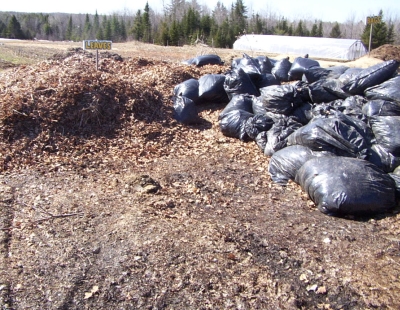 At Snakeroot, we use only bio-degradable organic mulches of various types. Not only does that mean we are not faced with the annual purchasing of these petrochemicals, and the fall labor chore of picking up and “throwing away” the plastic, but all of our mulches are turned under to become an integral part of our soil building program. Furthermore, we are utilizing mulching materials that for the most part would otherwise become wastes for our town dump to handle. As an added bonus, because of the relationship we have built with the town to become the residential disposal location for these mulching products, all of our mulch products come to us at almost no cost to ourselves in either labor or money. We have a brochure we distribute around town inviting folks to drop off their leaves. Of course we do have to discard over a hundred torn trash bags each year, but on the other hand we haven’t had to buy a trash bag in over a decade! At Snakeroot, we use only bio-degradable organic mulches of various types. Not only does that mean we are not faced with the annual purchasing of these petrochemicals, and the fall labor chore of picking up and “throwing away” the plastic, but all of our mulches are turned under to become an integral part of our soil building program. Furthermore, we are utilizing mulching materials that for the most part would otherwise become wastes for our town dump to handle. As an added bonus, because of the relationship we have built with the town to become the residential disposal location for these mulching products, all of our mulch products come to us at almost no cost to ourselves in either labor or money. We have a brochure we distribute around town inviting folks to drop off their leaves. Of course we do have to discard over a hundred torn trash bags each year, but on the other hand we haven’t had to buy a trash bag in over a decade!
Our mulching materials come to us via several methods over the course of a year. Newspapers are delivered daily to our door via subscription. Cereal boxes and pizza boxes arrive in the usual way and when empty are added to the pile of newspapers. In the fall and spring, residents bring carloads, van loads, trailer loads and pickup loads of leaves, pine needles, and hay, either bagged, baled or loose. Some days we get over a dozen deliveries, some days none. When the piles start to spread out, I use the bucket loader to push them together and pile them higher.
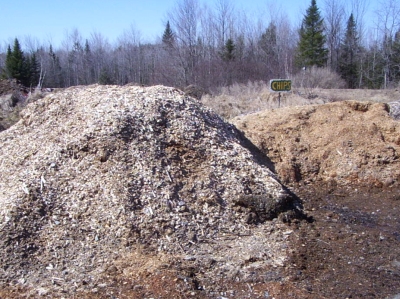 When the local electric company has the chipper truck trim under the lines, the chipping crew has a disposal problem once their truck is full. If we see them working nearby, we remind them where they can dump all they have, whenever they have them. Similarly, the Town Highway Dept. sometimes needs to chip fallen trees, and sends the dump truck of chips up to us. Some homeowners do likewise. For more on using chips, see our article In Praise of Chips. When the local electric company has the chipper truck trim under the lines, the chipping crew has a disposal problem once their truck is full. If we see them working nearby, we remind them where they can dump all they have, whenever they have them. Similarly, the Town Highway Dept. sometimes needs to chip fallen trees, and sends the dump truck of chips up to us. Some homeowners do likewise. For more on using chips, see our article In Praise of Chips.
What organic mulches do. As any organic farmer will tell you, nothing on the farm should be seen to have only one purpose. Organic mulches are an excellent example of this. In winter, the mulches even out the swings in temperature, causing the soil to slowly freeze, and then slowly thaw in the spring. Plants and bulbs like this. During the growing season, organic mulches keep the soil cool and moist, so sometimes irrigation is unnecessary even in a dry year. Organic mulches suppress weeds, especially the annual broadleaf weeds. Organic mulches add organic matter to the soil when turned under, but even before being turned under, they make the top inch of the soil more usable to the plant roots and earthworms than it would be otherwise, since it does not bake in the sun. When you don’t apply a mulch, you are essentially mulching your soil using your top ½” – 1″ of soil.
Once we have the mulches at hand, how do we use them? Much of our leaf pile will be used not for mulch at all, but for composting with cow manure when the dairy farmer delivers it. They get mixed together and turned several times during the year, then spread on the fields the next year. The rest of the leaf pile to be used for mulch gets sorted into regular leaves, pine needles or needle & leaf mixes, and shredded leaves.
We mulch our celery, tomatoes, peppers, asparagus, rhubarb, grapes, garlic, onion sets, and woody herbs. As each of these crops requires its own type of management, we use different kinds of mulches that will match the requirements of the plants. All of our other crops do not get mulched, although they may benefit from the previous crop’s mulch having been incorporated into the soil.
Celery get mulched with hay several inches thick. We grow a double row of celery on a foot wide, foot high bed, and the mulch goes along the sides and between the rows. Celery likes to grow in moist soil, and the thick layer of hay helps retain moisture and suppress weeds. The mulch goes on once the celery has been in the ground three to four weeks and gets tucked right up next to each plant. We have learned, however, NOT to mulch celeriac very heavily, as the continuous soil surface moisture causes the top of the celeriac roots to become hairy with tiny rootlets.
Tomatoes need to have the mulch applied after the June soil has warmed but before the plants tip over from the weight of their first fruits, or else the job will go much slower as you lift each plant carefully to tuck the mulch under it. Whole leaves work well for tomatoes, since they pack down into layers to suppress weeds, and are easy to tuck around the separate plants. Probably half our leaves are used to mulch our 3000 tomato plants. It’s a lot of work, but it means the plants don’t have to be trellised, and yet fruit won’t be on the soil. Plus, we don’t have to water the tomatoes as much.
Peppers have an upright growth habit, so mulching can be delayed longer than for tomatoes. Since they prefer a well-warmed soil, the delay in mulching only warms their roots more. Mid to late July is when we get around to mulching our peppers. Leaves, hay or chips work well for mulching peppers.
Asparagus is a perennial, and it has a vigorous sharp spear that emerges in the spring. Hence we mulch it with whole leaves, even covering the entire row several inches deep annually in late fall or early spring. Whole leaves are not only high in mineral content, but they mat down to form a barrier impenetrable to all but the most determined and energetic plants, such as asparagus. Also, the ends of the asparagus bed don’t go all the way to the edge of the garden, in order that an area can be tilled to prevent the perennial rhizome grasses from moving in.
Rhubarb is basically done the same as asparagus. Although not equipped with pointed growing tips, rhubarb is vigorous enough to shove aside the leaves blocking it from emerging each spring. An annual or bi-annual application of leaves seems to be all the rhubarb wants in order to keep going for a decade or more. The water-loving rhubarb roots appreciate the constant moisture found under several inches of leaves.
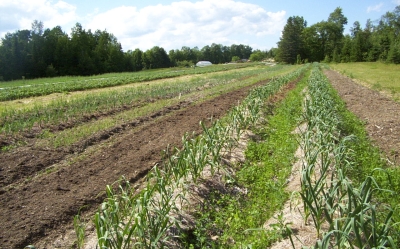 Garlic and Onion Sets get the same mulch treatment, although at different seasons because of their different planting times. Both the sets and cloves have more energy than weed seeds, thus are able to push thru quite a layer of mulch to reach the light. The only difficulty we have found is that using regular leaves (maple, oak, birch) in their whole state is that they tend to pack into mats which the garlic and onions spears find it difficult to pierce. Therefore we only use hay, shredded leaves, or pine needles and pine needle/leaf mixes, which neither blow away in the spring and fall winds, nor form an impenetrable mat. Yet they do hold in ground moisture and—for the garlic—keep the cloves from frost heaving out of the ground during the winter. Also, these mulches provide a layer of darkness so that most of the annual weeds will not grow under it. Garlic is mulched right after it is planted in November. Onion sets are mulched within two weeks of spring planting, that is, before they start to emerge so as not to break or bury the shoots when applying the mulch. In the top photo from June ’04, the garlic has been mulched with hay in the foreground and leaves further back. Three and four beds to the left are onions mulched with wood chips. The garlic aisles have had no mulch applied, and are weedy. We are now mulching the aisles with whole leaves to avoid having to weed them, as you can see from the bottom May ’05 photo with garlic beds on the left and onion sets (yet to emerge) on the right. Garlic and Onion Sets get the same mulch treatment, although at different seasons because of their different planting times. Both the sets and cloves have more energy than weed seeds, thus are able to push thru quite a layer of mulch to reach the light. The only difficulty we have found is that using regular leaves (maple, oak, birch) in their whole state is that they tend to pack into mats which the garlic and onions spears find it difficult to pierce. Therefore we only use hay, shredded leaves, or pine needles and pine needle/leaf mixes, which neither blow away in the spring and fall winds, nor form an impenetrable mat. Yet they do hold in ground moisture and—for the garlic—keep the cloves from frost heaving out of the ground during the winter. Also, these mulches provide a layer of darkness so that most of the annual weeds will not grow under it. Garlic is mulched right after it is planted in November. Onion sets are mulched within two weeks of spring planting, that is, before they start to emerge so as not to break or bury the shoots when applying the mulch. In the top photo from June ’04, the garlic has been mulched with hay in the foreground and leaves further back. Three and four beds to the left are onions mulched with wood chips. The garlic aisles have had no mulch applied, and are weedy. We are now mulching the aisles with whole leaves to avoid having to weed them, as you can see from the bottom May ’05 photo with garlic beds on the left and onion sets (yet to emerge) on the right. 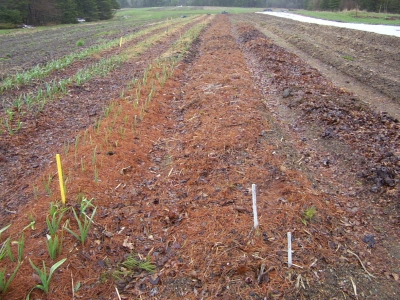
Tips about using organic mulches:
- For those crops yearning for a warm soil, wait until the soil has had time to warm up—usually a few weeks after the last frost—before laying down the mulch.
- Depending upon the length of the rotation cycle, we rotate our perennial beds into annuals for a few years in order to rid the perennial beds of perennial weeds. Although not practical for rhubarb, grapes and asparagus, this does work well for the shorter-lived woody herbs such as sage, thyme, winter savory, lavender, and oregano. Sometimes we dig up a few remaining perennials and move them to new perennial beds, removing any embedded perennial weeds from them in the process.
- Applying a mulch of pine needles or shredded leaves is easier if shaken from a wide bucket over the bed. With this method little or no further evening of the mulch is required. A five-tined fork works well, too, but is slower.
- Oak leaves decompose very slowly due to their tannin content, and tend to be more acidic than other broad leaves. Thus they make very good mulch for raspberry and blueberry plants. Oak leaves were once used as a source of tannin for tanning leather.
- If using oak leaves or pine needles on a regular garden area that does not require extra acidity, a sprinkling of lime or wood ashes can be applied on top of the mulch. A single application of these mulches ever few years (since the crop they are applied to will be rotated to a new location the next year) will not significantly lower the pH. Continued applications on the same location will, however. Remember, the mulches are on top of the soil the first year, therefore they don’t add most of their acidity until turned under in the fall.
- Bagged leaves and baled hay are easier to move to where they are going to be used, than when loose. Keep them that way until they are ready to be used.
- You can get fairly efficient at detecting shredded leaves or pine needles in an opaque bag simply by look and feel. We separate these out as soon as they arrive and move them to where they will be used.
- Leftover leaves can be kept over for a year or two to become leaf mold, an excellent additive to potting soil or raised beds. Turn them once or twice to enhance rotting.
- Never use a plastic mulch to suppress rhizome grasses, as they will penetrate the mulch, thus nailing it to the ground in a thousand places.
- You can use the physical properties of baled versus loose hay to your advantage. Loose hay tucks into tight space, such as between celery rows. Sections of baled hay work well as impenetrable barriers on the edges of beds or in broad areas. Be sure to overlap them so no light gets through to the soil.
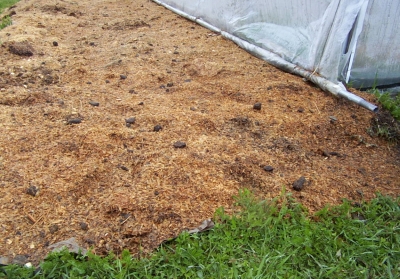 All high-cellulose items such as sawdust, shavings and wood chips are very slow to degrade once turned under and absorb nitrogen while rotting, robbing it from crop plants. Although they work well during the mulch year, extra nitrogen (compost, liquid fish) should be added the next year to supply sufficient nitrogen for both the mulch to rot and the crops to grow. It is better to use these items to mulch perennial areas where they will not be incorporated into the soil, except by the microbes and earthworms over time. All high-cellulose items such as sawdust, shavings and wood chips are very slow to degrade once turned under and absorb nitrogen while rotting, robbing it from crop plants. Although they work well during the mulch year, extra nitrogen (compost, liquid fish) should be added the next year to supply sufficient nitrogen for both the mulch to rot and the crops to grow. It is better to use these items to mulch perennial areas where they will not be incorporated into the soil, except by the microbes and earthworms over time.- To eliminate rhizome grasses we first layer the ground with ¼” of wet newspaper or cardboard, overlapping them by six inches. Then we apply a few inches of chips or sawdust to keep them from drying out and blowing away. Within a year, the newspapers are completely biodegraded, and most of the grasses underneath are dead. The few that do find a way to sunlight are easily pulled, as their roots are now close to the surface running just below the mulch. This is a technique we use next to the greenhouses that sit in the fields (see photo), to prevent grasses from invading the greenhouses. For more on mulching rhizome grass, see our article Combatting Quackgrass with Mulch.
|
 At Snakeroot, we use only bio-degradable organic mulches of various types. Not only does that mean we are not faced with the annual purchasing of these petrochemicals, and the fall labor chore of picking up and “throwing away” the plastic, but all of our mulches are turned under to become an integral part of our soil building program. Furthermore, we are utilizing mulching materials that for the most part would otherwise become wastes for our town dump to handle. As an added bonus, because of the relationship we have built with the town to become the residential disposal location for these mulching products, all of our mulch products come to us at almost no cost to ourselves in either labor or money. We have a
At Snakeroot, we use only bio-degradable organic mulches of various types. Not only does that mean we are not faced with the annual purchasing of these petrochemicals, and the fall labor chore of picking up and “throwing away” the plastic, but all of our mulches are turned under to become an integral part of our soil building program. Furthermore, we are utilizing mulching materials that for the most part would otherwise become wastes for our town dump to handle. As an added bonus, because of the relationship we have built with the town to become the residential disposal location for these mulching products, all of our mulch products come to us at almost no cost to ourselves in either labor or money. We have a  When the local electric company has the chipper truck trim under the lines, the chipping crew has a disposal problem once their truck is full. If we see them working nearby, we remind them where they can dump all they have, whenever they have them. Similarly, the Town Highway Dept. sometimes needs to chip fallen trees, and sends the dump truck of chips up to us. Some homeowners do likewise. For more on using chips, see our article
When the local electric company has the chipper truck trim under the lines, the chipping crew has a disposal problem once their truck is full. If we see them working nearby, we remind them where they can dump all they have, whenever they have them. Similarly, the Town Highway Dept. sometimes needs to chip fallen trees, and sends the dump truck of chips up to us. Some homeowners do likewise. For more on using chips, see our article  Garlic and Onion Sets get the same mulch treatment, although at different seasons because of their different planting times. Both the sets and cloves have more energy than weed seeds, thus are able to push thru quite a layer of mulch to reach the light. The only difficulty we have found is that using regular leaves (maple, oak, birch) in their whole state is that they tend to pack into mats which the garlic and onions spears find it difficult to pierce. Therefore we only use hay, shredded leaves, or pine needles and pine needle/leaf mixes, which neither blow away in the spring and fall winds, nor form an impenetrable mat. Yet they do hold in ground moisture and—for the garlic—keep the cloves from frost heaving out of the ground during the winter. Also, these mulches provide a layer of darkness so that most of the annual weeds will not grow under it. Garlic is mulched right after it is planted in November. Onion sets are mulched within two weeks of spring planting, that is, before they start to emerge so as not to break or bury the shoots when applying the mulch. In the top photo from June ’04, the garlic has been mulched with hay in the foreground and leaves further back. Three and four beds to the left are onions mulched with wood chips. The garlic aisles have had no mulch applied, and are weedy. We are now mulching the aisles with whole leaves to avoid having to weed them, as you can see from the bottom May ’05 photo with garlic beds on the left and onion sets (yet to emerge) on the right.
Garlic and Onion Sets get the same mulch treatment, although at different seasons because of their different planting times. Both the sets and cloves have more energy than weed seeds, thus are able to push thru quite a layer of mulch to reach the light. The only difficulty we have found is that using regular leaves (maple, oak, birch) in their whole state is that they tend to pack into mats which the garlic and onions spears find it difficult to pierce. Therefore we only use hay, shredded leaves, or pine needles and pine needle/leaf mixes, which neither blow away in the spring and fall winds, nor form an impenetrable mat. Yet they do hold in ground moisture and—for the garlic—keep the cloves from frost heaving out of the ground during the winter. Also, these mulches provide a layer of darkness so that most of the annual weeds will not grow under it. Garlic is mulched right after it is planted in November. Onion sets are mulched within two weeks of spring planting, that is, before they start to emerge so as not to break or bury the shoots when applying the mulch. In the top photo from June ’04, the garlic has been mulched with hay in the foreground and leaves further back. Three and four beds to the left are onions mulched with wood chips. The garlic aisles have had no mulch applied, and are weedy. We are now mulching the aisles with whole leaves to avoid having to weed them, as you can see from the bottom May ’05 photo with garlic beds on the left and onion sets (yet to emerge) on the right. 
 All high-cellulose items such as sawdust, shavings and wood chips are very slow to degrade once turned under and absorb nitrogen while rotting, robbing it from crop plants. Although they work well during the mulch year, extra nitrogen (compost, liquid fish) should be added the next year to supply sufficient nitrogen for both the mulch to rot and the crops to grow. It is better to use these items to mulch perennial areas where they will not be incorporated into the soil, except by the microbes and earthworms over time.
All high-cellulose items such as sawdust, shavings and wood chips are very slow to degrade once turned under and absorb nitrogen while rotting, robbing it from crop plants. Although they work well during the mulch year, extra nitrogen (compost, liquid fish) should be added the next year to supply sufficient nitrogen for both the mulch to rot and the crops to grow. It is better to use these items to mulch perennial areas where they will not be incorporated into the soil, except by the microbes and earthworms over time.